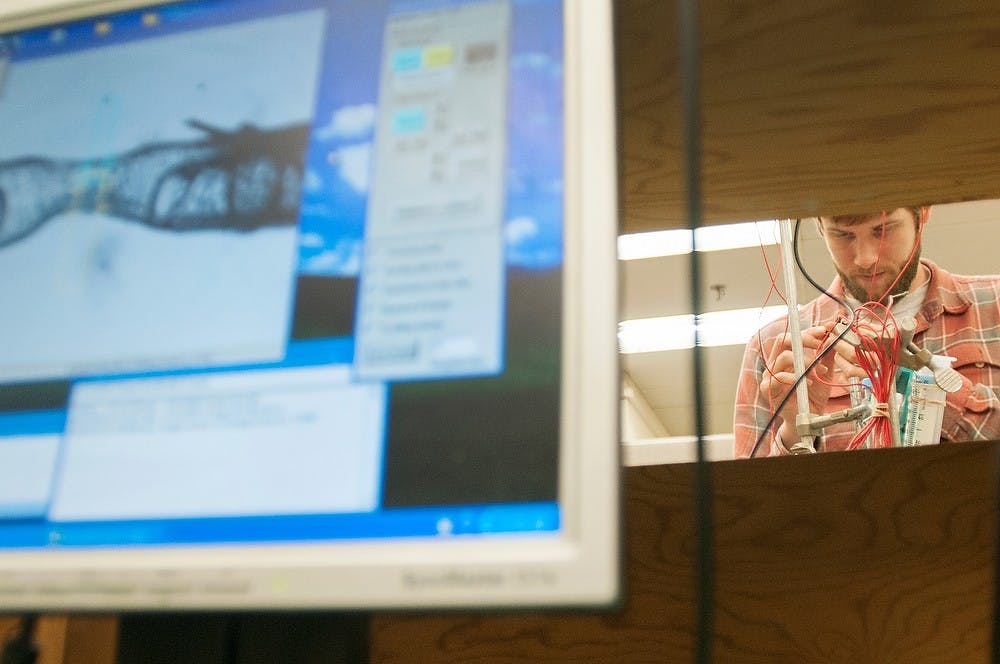It didn’t take long for James Galligan, director of the MSU Neuroscience Program, to answer a question seemingly simple in nature, but amazingly complex in reality: How would you describe the functions of the human brain?
“Overwhelming,” Galligan said. “Trying to comprehend the most complex organ in the human body is the next guiding theme for scientists nationally and at MSU. Going to the moon was one thing, and now it’s understanding the brain.”
MSU’s brain-research portfolio is among the most diverse in the nation. Faculty members and undergraduate students across campus are digging into the antique secrets of the brain from just about every imaginable angle.
Laura Symonds, director of the undergraduate neuroscience program, said MSU is looking to provide students with an in-depth, rigorous neuroscience program so when they graduate they will bolster the university’s positive reputation for neuroscience education and research.
As MSU attempts to become a leading brain-research institution, the university is extending its reach into a variety of different cognitive studies.
Neuroscience at MSU
The neuroscience major was approved by MSU last August, and Symonds said the university has been designing the undergraduate program for almost 10 years.
“(In our departments), we try to cover as many subdisciplines of neuroscience as we can,” Symonds said. “(We discuss) anything from neural genetics, neural engineering, to neural behavior.”
Symonds said the wide varieties of the neuroscience topics comes from the unique position MSU is in by building such a strong research profile.
“We expose our students to cutting-edge neuroscience technology, both in the laboratory — which is required in the major — but also in lots of research opportunities for our undergraduate majors,” Symonds said. “It’s important neuroscience majors come out of MSU really educated.”
Human biology senior Mary Lian is a part of the Research Education Program to Increase Diversity in Health Researchers at MSU. Lian said the program requires students to take basic research classes during the spring semester before being matched to a specific interest area with a mentor in the summer.
How the nervous system affects the brain
Galligan said the study of neuroscience has attracted more interest on campus and on a national level as of late. Galligan’s primary appointment is in the pharmacology and toxicology departments.
Two topics they cover there are blood pressure control of a human and the motor functions proportions of gastric and intestinal content along the length of the gut.
Jon Bomar, a graduate student in the neuroscience program, said they are studying how the nervous system contributes to a higher blood pressure.
“We have a rat model that reacts to salt the same way as many humans do,” Bomar said. “One of the unique things we found in this model is the increase in blood pressure activates the immune system, and the immune system then interacts with the nerve endings in the blood vessels, and this changes how those nerve endings function.”
The brain from an athlete’s perspective
Much of the current research involving brain activity, both at MSU and nationwide, is tied to concussions and potential athletic detriments.
In a sport such as football, the brain can withstand multiple traumatic blows.
Accounting senior and former MSU football player Nate Klatt said he has suffered three concussions this past semester, two of which were severe, resulting in a medical disqualification from the team. Klatt said he felt disoriented after the three blows to his head.
“When you get hit hard in the head, you kind of feel lost for a second,” Klatt said.
Support student media!
Please consider donating to The State News and help fund the future of journalism.
The Department of Radiology did a study on Klatt’s brain before and after he had his concussions.
Klatt said the doctors there don’t try to scare anyone, but they tell you to get a lot of rest after they give you an impact test.
“The impact test focuses on how well your memory and your brain are working (after a concussion),” Klatt said.
“If you don’t pass those tests, they do not let you on the practice field or let you play in the next game. Sports is not worth it to mess your health and life over.”
Discussion
Share and discuss “Brainstorming” on social media.





